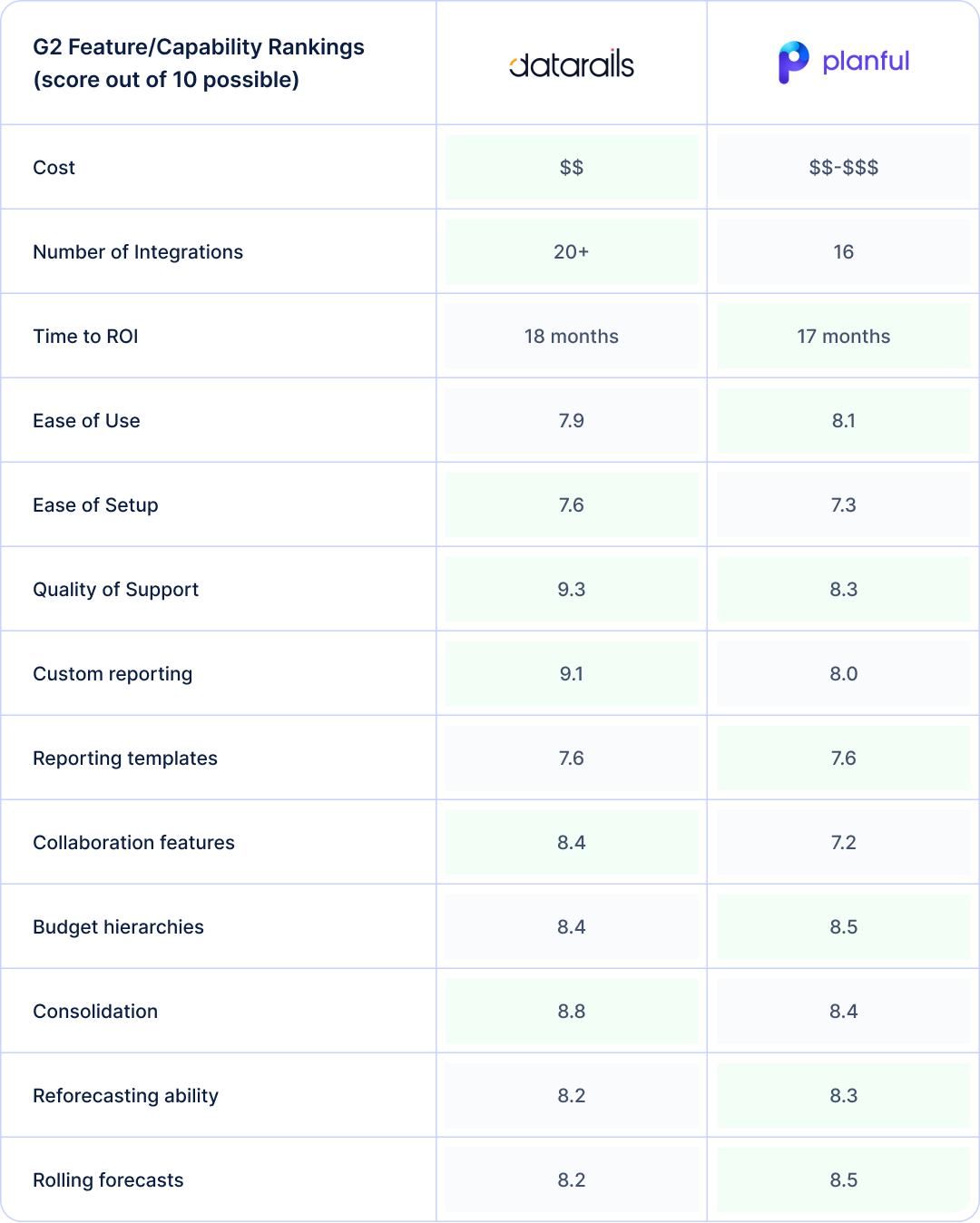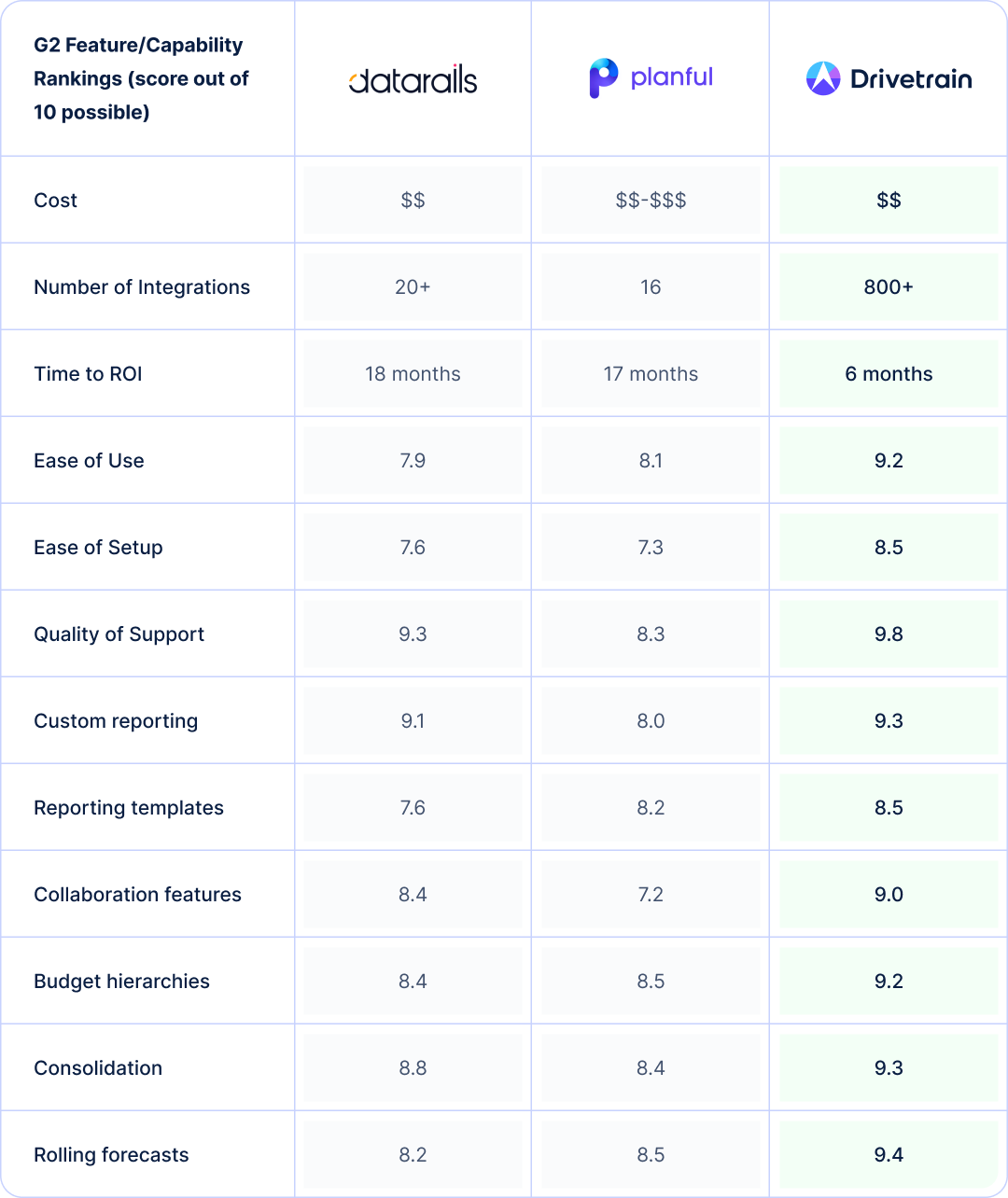Evaluating Planful vs. Datarails for your FP&A software? This guide compares features, integrations, implementation timelines, and best‑fit scenarios so you can choose confidently.
When your finance team outgrows Excel, two names are likely to show up on your shortlist: Planful and Datarails.
Both tools promise to pull you out of spreadsheet chaos—but they approach that goal from opposite directions.
Planful prioritizes structured workflows, built-in governance, and consolidation controls. Datarails, by contrast, leans into the speed and familiarity of Excel with automation layered on top.
While both aim to reduce manual work and improve forecasting accuracy, their trade-offs become apparent during the implementation phase and when companies start to scale. Planful often demands longer setup cycles and administrative expertise. Datarails deploys faster but can introduce governance challenges and performance limits as complexity grows.
This guide is designed for mid-market and enterprise finance teams evaluating FP&A tools. It draws on verified G2 reviews, implementation reports, and customer feedback to help you evaluate based on the following;
- Implementation and ownership: Who runs the models, how fast they can start, and how often they’ll need help?
- Total cost of ownership: How does licensing, services, hidden dependencies, and admin load add up over time?
- Scalability and modeling control: How well does each tool handle multi-scenario, multi-entity planning at speed?
- Integration reliability: How consistently does data flow from ERP, CRM, HRIS, and payroll sources without breaking?
- AI that actually reduces effort: Is it just assistant features or measurable gains in forecasting, reforecasting, and reporting speed?
Planful: strengths, limitations, and best fit
Planful is an enterprise-grade FP&A platform built for organizations that operate across multiple entities, regions, or business lines. It excels in structured environments where governance, compliance, and repeatable financial processes are essential. The platform’s end-to-end coverage of budgeting, consolidation, and forecasting gives finance leaders a unified system for managing the close process with rigor and auditability.
Planful’s strengths are clearly visible in a predictable and process-heavy setting. Automated consolidation and strong version control minimize the need for manual intervention, while AI features, such as variance detection and narrative generation, help in speeding up financial reporting. However, those benefits come with steep trade-offs as implementation often involves third-party consultants and long ramp-up times. Plus, its rigid architecture and limited modeling dimensions can limit the flexibility of teams that rely on rapid iteration or scenario testing.
Performance and usability also draw mixed feedback from the users. While Planful’s structured workflows appeal to enterprise finance teams, users also note slower refreshes on large datasets and an interface that can feel less intuitive and user-friendly compared to newer, web-native FP&A tools.
In short, Planful is a strong fit for organizations that prioritize control, compliance, and predictability over speed. For dynamic, high-growth teams that iterate often or need self-service modeling, the platform’s governance strengths may double as operational constraints.
What are Planful’s core strengths?
- Structured workflows for complex enterprises: Planful provides end-to-end workflows covering budgeting, consolidation, and reporting for mid-market and enterprise teams managing multiple entities or currencies.
- Governance and auditability: Built-in approval chains, version control, and audit trails support compliance and accountability across planning processes.
- Consolidation and close automation: Automates data collection, reconciliation, and intercompany eliminations—reducing manual dependencies in the financial close process.
What are Planful’s limitations?
- Dimensional modeling: Planful supports up to eight reporting dimensions, which can constrain models with deep product, region, or customer hierarchies.
- Extended implementation timelines: Deployments typically require third-party consultants and several months of setup, delaying time-to-value and increasing cost.
- Performance degradation with scale: Users report slower refresh rates and manual data updates when working with large datasets.
- Limited native integration coverage: Many core system connections require middleware or custom configuration, raising IT overhead.
- Complex configuration and user setup: Report templates and user access settings are described as difficult to configure without technical assistance.
- Rigid architecture: The platform’s structure benefits auditability but limits agility for teams needing frequent re-forecasting or rapid structural changes.
When does Planful make sense?
Planful suits multi-entity, governance-focused organizations that prioritize structured processes over rapid flexibility, such as enterprises in regulated sectors or those managing complex consolidations.
For teams that have predictable planning cycles and need strong governance and control over workflow ownership, Planful may make sense. However, those with complex multi-dimensional modeling needs exceeding eight dimensions may find Planful limiting.
Datarails: strengths, limitations, and best fit
Datarails is built around the idea of preserving the spreadsheet as finance’s core workspace. It targets SMB and mid-market companies, allowing teams to continue working in Excel while layering automation, collaboration, and version control on top. This approach minimizes change management, making adoption faster for teams reluctant to give up their spreadsheets and who want quick wins in their consolidation and reporting efforts.
Datarails’ greatest strength lies in its ease of use and its ability to automate data collection and variance workflows. This means less manual work and a faster monthly close. The platform’s AI features also add some lift by generating KPI summaries and board-ready reports in minutes. However, the same Excel foundation that makes it easy to adopt also limits its scalability. As data volumes and model complexity grow, users report slower refreshes and performance bottlenecks.
Integrations are somewhat limited compared to other FP&A software, but do cover some of the more common ERP and accounting tools. Datarails users have also commented that reporting visuals are basic when compared with modern web-native FP&A platforms. Meanwhile, implementations, though marketed as fast, can stretch over several months as teams configure data flows and permissions.
For finance leaders who want to modernize without rebuilding their models from scratch, Datarails offers an accessible bridge between Excel and structured FP&A. But for organizations anticipating rapid growth or needing multi-dimensional modeling, Datarails might become more of a ceiling than a springboard.
What are Datarails’ core strengths?
- Excel-native environment: Extends Excel with centralized data management, version control, and audit trails while maintaining the familiar spreadsheet interface.
- Low change management overhead: Allows finance teams to continue existing workflows and leverage existing Excel skills, minimizing disruption during adoption.
- Automated consolidation and variance reporting: Aggregates financial data from multiple entities and automates budget vs. actual comparisons.
- Multi-entity rollup and elimination support: Handles automated consolidation across subsidiaries with intercompany eliminations.
What are the common limitations with Datarails?
- Performance issues at scale: Excel-based architecture leads to slow refreshes, instability, and system lag when working with large datasets or complex models.
- Scalability constraints: Limited capacity for driver-based or multi-dimensional modeling; users report outgrowing the platform as complexity increases.
- Lengthy onboarding: Implementation timelines take longer than expected for an Excel-based solution.
- Learning curve for advanced functions: Some workflows require understanding custom formulas and syntax, creating friction for non-technical users.
- Basic reporting and visualization: Report builder has limited design flexibility and often requires manual formula adjustments when adding new accounts or dimensions.
When does Datarails make sense?
Datarails fits mid-market finance teams that want to modernize Excel-based processes without a full replatform. It delivers fast wins in terms of consolidation and reporting efficiency for organizations with light to moderate modeling complexity.
However, teams anticipating high data growth, advanced scenario modeling, or enterprise-grade scalability may outgrow its Excel-based design sooner than expected.
Planful vs. Datarails: direct feature and experience comparison
Planful’s structured, governance-first architecture appeals to enterprises that need control and auditability across multi-entity planning. Datarails, in contrast, extends the Excel environment with automation and collaboration, favoring teams that value speed and familiarity.
User feedback highlights a similar trade-off for both tools: implementation drag, integration complexity, and ongoing admin effort. Planful’s deployments are longer and often third-party consultant-driven, while Datarails’ Excel-based setup still requires weeks of configuration and testing before teams can scale it reliably. In both cases, hidden dependencies such as IT support for integrations or dedicated model admins inflate the total cost of ownership.
Performance at scale also separates them in terms of the user experience they offer. Planful’s governed workflows slow under heavy data volumes, while Datarails’ Excel foundation introduces refresh delays and instability as files grow. Both platforms deliver strong consolidation and reporting once configured, but maintenance overhead and data-sync friction remain recurring pain points.
AI capabilities are another area where expectations outpace outcomes that either platform can provide. Planful’s AI assists with anomaly detection and narrative generation but still depends on structured data and human validation. Datarails adds conversational and storyboard features, yet reviewers note they operate more like guided templates than autonomous analysis. Neither tool yet offers the kind of continuous, AI-driven forecasting or scenario modeling that finance teams increasingly expect from next-generation AI-powered FP&A software.
Overall, both solutions represent mature solutions, but users consistently cite slower time-to-value, heavier IT involvement, and limited AI maturity as the main friction areas to evaluate when budgeting for long-term scalability.

Planful vs. Datarails: Where both platforms fall short for dynamic finance teams
While both Planful and Datarails provide a meaningful lift over Excel and legacy planning tools, they also introduce new operational risk, especially for fast-moving teams and high-complexity environments.
Across verified reviews, recurring themes include longer-than-expected setup cycles, heavy admin and IT dependence, rising total cost of ownership (TCO), unclear integration ownership, and underdeveloped AI capabilities that don’t yet translate into real planning gains.
While these issues manifest differently, Planful, through its rigidity and consultant reliance, and Datarails, through its Excel architecture and maintenance burden, the result is the same: slower iteration, fragile data flows, and reduced confidence in the numbers when models or structures change.
Consultant-heavy, complex setup delays time-to-value
In both tools, early momentum often stalls between implementation and go-live because ownership of models, data pipelines, and post-launch configuration remains ambiguous:
- Planful: Its complex configuration demands specialized administrators or external consultants even after go-live. Finance teams frequently rely on IT or vendor partners for structural changes, slowing responsiveness to business shifts.
- Datarails: Its Excel-based foundation allows a fast initial rollout but introduces governance sprawl once multiple models or entities are connected. Teams often need a dedicated finance owner or IT resource to manage version control, refresh failures, and data hygiene.
- Why it matters: CFOs evaluating FP&A tools increasingly prioritize predictable deployment timelines and clear internal ownership. Both platforms’ reliance on external support or internal super-users can delay ROI and inflate lifetime costs.
Agility that breaks down at scale
Both vendors struggle to balance enterprise-grade governance with the rapid scenario iteration modern FP&A teams require:
- Planful: The platform’s controlled workflows are valued in audit-sensitive environments but can impede responsiveness when business drivers or hierarchies change. With only eight supported dimensions, teams modeling multiple regions, products, or revenue streams must resort to workarounds or offline Excel layers.
- Datarails: Its Excel-native agility benefits smaller datasets but becomes a constraint for high-volume or multi-scenario models. Users report refresh delays and freezes, and versioning conflicts as file sizes expand.
- Why it matters: Finance leaders need to model outcomes quickly across entities, products, and markets without waiting on admins or encountering lag. Both platforms’ architectures create friction once planning moves from static to dynamic.
Fragile data pipelines and weak controls erode trust
Both tools depend heavily on consistent integration stewardship, yet neither provides clear built-in accountability for pipeline monitoring or data lineage:
- Planful: Integrations with ERP, CRM, and HRIS systems often require middleware or ongoing partner involvement. Many teams still export data into Excel or BI tools for validation and board reporting, fragmenting the “single source of truth.”
- Datarails: Its spreadsheet-centric workflow complicates centralized controls where each model carries its own data refresh cadence, mapping logic, and potential for manual edits. That flexibility can degrade auditability over time.
- Why it matters: CFOs and controllers rely on trustworthy data pipelines and reproducible calculations. When integrations and controls rely on ad-hoc owners, teams spend more time reconciling discrepancies than analyzing results, undermining the confidence in reported numbers.
Both Planful and Datarails deliver structured FP&A automation, but neither eliminates the operational friction that modern finance teams usually face, such as dependency on external specialists, limited scalability, and fragile integrations that erode trust in data.
These gaps underscore why dynamic finance teams increasingly look for platforms that blend enterprise control with self-service agility and continuous, AI-driven accuracy.
How Drivetrain outperforms Planful and Datarails
Both Planful and Datarails help finance teams move beyond spreadsheet chaos, but neither fully resolves the friction points modern FP&A teams tend to face, such as long onboarding cycles, complex ownership models, rigid architectures, and fragile data pipelines.
Drivetrain is an FP&A platform built to close these gaps. It combines finance-first ownership with rapid setup, a flexible modeling engine, and over 800 pre-built integrations to offer modern FP&A teams the control of an enterprise platform with the agility of a modern, AI-native system. The result is faster value realization, continuous adaptability, and trustworthy, always-fresh data without IT bottlenecks.

Faster ramp-up with finance-first ownership
Most FP&A tools claim fast time-to-value, but few deliver it without external consultant dependencies. Drivetrain does.
Typical Planful deployments can take 4–5 months and rely on external implementation partners. Datarails may start faster, yet it still often requires around 2–4 months of mapping, testing, and governance setup before teams can use it reliably. By contrast, Drivetrain’s in-house onboarding gets finance teams up and running in 4–6 weeks, that’s a 3–4x faster time-to-value that doesn’t depend on outside consultants.
Drivetrain’s finance-first architecture means ownership stays squarely within your team. You can update models, add entities, or change drivers without breaking integrations or waiting on technical staff. This eliminates the post-go-live dependency loop that slows Planful and Datarails users down.
Practical migration support and structured onboarding milestones ensure teams sustain momentum after launch. Once live, self-service configuration allows ongoing iteration so finance can move from static forecasting to continuous, assumption-driven planning with minimal friction.
Flexible, governed modeling without spreadsheet sprawl
Drivetrain eliminates the false trade-off between structure and speed. It provides finance leaders with full governance, version control, and auditability, without the rigidity of Planful’s eight-dimensional limit or the sprawl that comes with Datarails’ Excel-bound models.
Its powerful, multi-dimensional calculation engine enables modeling across unlimited entities, products, or regions in real-time, with built-in scenario branching and driver-based logic. Analysts can run “what-if analysis” cycles instantly, compare scenarios side-by-side, and reforecast continuously without having to wait for admins or consultants to make back-end changes.
Where Planful slows under data volume and Datarails falters under Excel load, Drivetrain’s cloud-native performance stays consistent. It’s flexible enough for analysts to experiment and governed enough for CFOs to trust the outputs while making agility a repeatable process, not a risk.
Robust integrations for reliable data finance teams can trust
Integrations are where most FP&A implementations stall. However, this is where Drivetrain accelerates value.
Planful connects to roughly 16 systems and often requires middleware or IT oversight. Datarails extends to around 20+ ERP and accounting tools. Drivetrain, by comparison, offers 800+ native integrations spanning ERP, CRM, HRIS, billing, and data warehouses.
These integrations plug-and-play, most can be installed and configured in minutes. They’re also business-manageable, meaning finance teams, not engineers, can add new data sources or entities as the business evolves. In addition, built-in reconciliation, continuous anomaly monitoring that leverages machine learning, and data lineage tracking ensure every refresh and rollup is validated automatically, eliminating hours of painstaking manual data hygiene work. Got a new data set to bring into the platform? Drive AI can transform your data to make it model-ready in minutes.
This reliability, augmented with real AI capabilities, translates to trust. When assumptions change or new dimensions are added, Drivetrain’s pipelines adapt automatically, keeping models, reports, and dashboards in sync without reconfiguration or downtime. Together, these capabilities make Drivetrain the clear choice for finance teams that want control and speed without compromise.
With these advantages in mind, let’s look at how to evaluate which FP&A platform best fits your team.
A decision framework for CFOs
The right FP&A platform depends on the team’s size, technical resources, modeling complexity, and growth trajectory. That’s why, to help you decide, we’ve built the checklist below to provide a practical framework that’ll help you evaluate where each vendor aligns.
1. Team size and technical resources
- Can your current team realistically implement and manage this tool without full-time admin support?
- Does the platform offer in-house onboarding, or is partner-led setup required?
- Can analysts and planners make day-to-day updates without IT or any consultant’s involvement?
- Is there self-service training or documentation to support internal ownership?
2. Modeling complexity and scenario agility
- Can the tool handle multi-scenario planning without extensive rework?
- Are there limits on how many dimensions you can model?
- Does the tool support rolling forecasts and monthly reforecasts?
- Can you run what-if cycles quickly without breaking the existing structure or waiting on admins to help you out?
3. Integrations and their flexibility
- Does the platform connect natively to your ERP, CRM, HRIS, billing, and data warehouse?
- Are those connections real-time?
- How much IT involvement is needed to maintain or update those integrations?
- Can finance manage data mapping or hierarchy changes themselves?
4. Scalability and performance
- Will performance degrade as your model grows?
- Does it support multi-entity, multi-currency, and acquisition-driven businesses?
- Are audit trails and versioning built in?
- Does the platform support flexible workflows without compromising governance?
5. Platform architecture
- Does the tool require Excel or can it run independently?
- How does it balance flexibility with model integrity?
- Can multiple users collaborate without version conflicts?
- Are changes auditable without manual backups?
- Are AI features “bolted on” or built into the core architecture of the platform?
6. Ownership model
- Who owns model logic and maintenance? Is it finance, IT, or a consultant for hire?
- Can finance independently manage forecasting, reporting, and scenario planning?
- Is vendor support required even for small changes like adding KPIs?
7. Growth trajectory and future-proofing
- Can the platform scale as you add entities, products, or markets?
- Does it support mergers and acquisitions or departmental expansion?
- Are there any limitations that could potentially force a re-platform within the next 12 to 24 months?
Choosing your FP&A partner
Based on the evaluation framework above, it’s clear that every FP&A platform has its strengths and limits. Ultimately, the right choice depends on your team’s need for structure, agility, and scale.
That being said, it’s clear that Planful delivers structure and control for finance organizations with complex consolidation and governance requirements. It’s best suited for large, compliance-driven enterprises that prioritize auditability and formal workflows over flexibility.
Meanwhile, Datarails accelerates Excel-based automation for smaller or mid-market teams that value speed, familiarity, and quick wins within a spreadsheet-native environment. It’s a strong transitional option for teams modernizing their reporting processes but not yet ready for a full FP&A transformation.
Drivetrain, however, bridges the best of both worlds with an AI-native, finance-owned platform that combines enterprise-grade control with startup-speed agility. It deploys in 4-6 weeks, scales effortlessly as your business grows, while keeping ownership firmly in the hands of finance, instead of IT or any other third-party consultants.
Plus, Drivetrain unifies data from any system with 800+ native connectors, giving finance teams a single, reliable source of truth. Its AI-native architecture automates forecasting, scenario modeling, variance analysis, and narrative reporting, transforming the planning experience from manual upkeep to continuous insight that syncs automatically.
Ultimately, the best FP&A platform is the one that meets your team where you are and scales with where you’re headed. Whether you’re moving beyond your first spreadsheet model or standardizing global forecasts across multiple entities, Drivetrain helps you plan faster, collaborate smarter, and deliver sharper insights without compromise.
Book your demo to see for yourself how Drivetrain can meet the needs of your finance team.
Frequently asked questions
Planful implementations typically stretch to 5 months due to complex setup and third-party consultant dependency. Datarails improves that with less than 4 months on average, which is fast for the category, but still requires significant internal coordination.
Drivetrain, by contrast, completes full onboarding in 4–6 weeks. Its in-house onboarding team partners directly with finance to migrate models, configure integrations, and validate data without middleware or consultants. This shortens time-to-value by more than 70% without the governance gaps that often accompany “quick-start” deployments.
Both vendors have introduced AI assistants and predictive insights, but most reviews describe them as “assistive” rather than transformative:
- Planful’s AI helps identify anomalies and generate narrative summaries, but requires clean, structured data and manual validation.
- Datarails’ AI supports variance explanations and simple chat queries, yet users report limited depth beyond templated commentary.
In contrast, Drivetrain is AI-native by design, built with a vision for autonomous finance. Drive AI offers:
- AI Analyst (conversational interface to surface insights)
- AI model generator for automated financial model creation
- AI Anomaly detection across revenue, spend, and headcount
- AI Transforms (natural-language data transformation)
Migration is often a blind spot in FP&A buying cycles, where most tools require manual remapping of accounts, drivers, and dimensions. Planful and Datarails both need third-party consultant or vendor involvement, extending timelines and costs.
Drivetrain simplifies this process through guided migration playbooks and hands-on support. Its customer success team provides one-on-one onboarding, a template library to accelerate model setup, and ongoing assistance from a dedicated CSM throughout your partnership.
Only up to a point. Community feedback consistently points to performance ceilings and spreadsheet sprawl once models exceed a few dozen entities or dimensions. As datasets grow, manual refreshes, broken formulas, and unstable files become recurring issues.
While Excel-native tools like Datarails can be a fast bridge, modern FP&A demands real-time, multi-scenario modeling that scales beyond desktop limitations. Drivetrain’s web-native, AI-powered engine handles high-dimensional data without sacrificing usability by combining the best of Excel’s flexibility with enterprise-grade control.
Datarails offers fast adoption and ease of use for spreadsheet-centric teams. Its Excel-native model lowers the learning curve, and its conversational AI accelerates simple reporting. The trade-off here is scalability.
However, as data volumes and collaboration needs expand, the same Excel foundation that drives adoption becomes a bottleneck, creating the very friction teams were trying to escape.
Planful leads in structured processes like financial consolidation, budgeting, and close management. Its governance and workflow capabilities make it attractive to enterprises that value compliance and auditability above agility.
However, those strengths come at a cost, such as heavier admin requirements, slower iteration, and dependency on consultants for model changes.
Planful’s structured, governance-first architecture appeals to enterprises that need control and auditability across multi-entity planning. Datarails, in contrast, extends the Excel environment with automation and collaboration, favoring teams that value speed and familiarity.
Both Planful and Datarails help finance teams overcome some of the issues inherent in spreadsheets. Planful provides stronger governance controls than what Excel offers out of the box, and Datarails adds automation and collaboration features that Excel natively lacks. However, both of these tools also come with some pretty significant limitations for mid-market and enterprise-level businesses, such as:
- Fragile data pipelines
- Consultant-heavy, complex setup
- Agility that breaks down at scale
For companies that need reliable data pipelines and performance at scale without the added costs and loss of agility, Drivetrain is an AI-native FP&A platform worth exploring. Its fast implementation and ease of use offers finance teams unparalleled agility in modeling.
Drivetrain also has a powerful, high-performance calculation engine under the hood to provide unlimited scalability. With 800+ native integrations, you can connect most any system within minutes for a reliable, real-time data flow and use Drive AI to build baseline models in seconds.

.svg)






.webp)



.svg)

